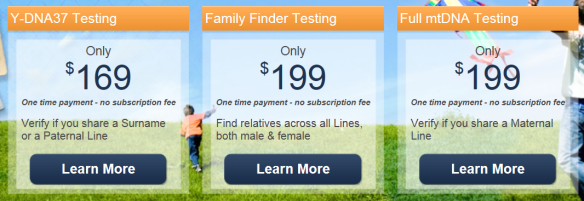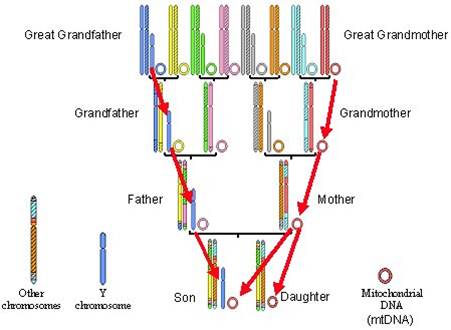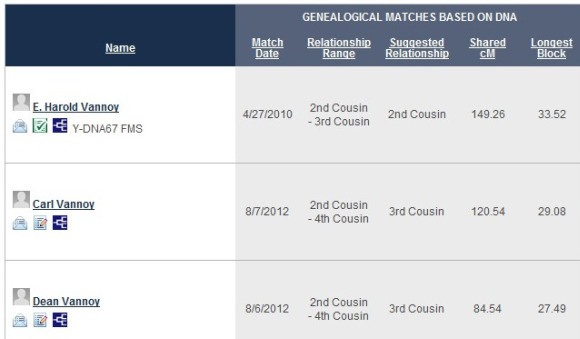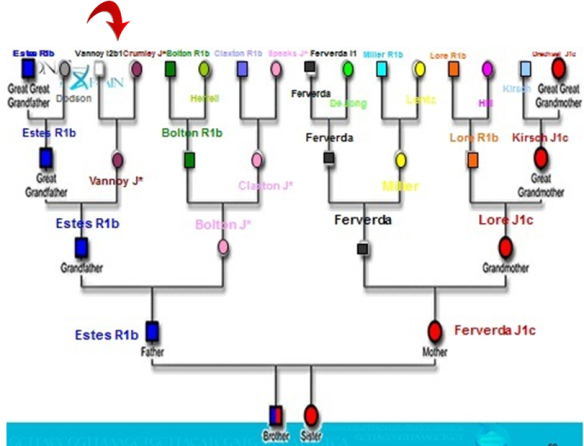I’m sometimes amazed at what people believe – and not just a few people – but a lot of people.
Recently, I ran across a situation where someone was just adamant that autosomal DNA could not help a female find or identify her father. That’s simply wrong. Incorrect. Nada! This isn’t, I repeat, IS NOT, true of autosomal testing.
Right here, on Family Tree DNA’s main page, it says as much.
Here is the product description for their Family Finder autosomal test:
“Family Finder uses autosomal DNA (inherited from both the mother and father, four grandparents, eight great-grandparents, etc.) to provide you a breakdown of your ethnic percentages and connect you with relatives descended from any of your ancestral lines within approximately the last 5 generations.”
Now the genetic genealogists among us will know right away where this myth that women can’t find their father using DNA came from. Indeed, it’s a true statement when you’re talking about Y-line DNA. Women don’t have a Y chromosome because it is passed only from father to son. The mitochondrial DNA that she does carry is from her mother’s maternal side, so before autosomal testing, there was no ready tool for women to identify or find missing fathers. For a long time, before autosomal testing, it was said as a general statement that women could not test for their father’s DNA. That statement was true in that context at that time. Not anymore.
The Times, They are A’Changin’
Today, however, there are 4 different DNA tests/tools for DNA testing, all with different purposes and that can be used in different ways, often in tandem.
Where the Y-line test tests just the Y chromosome, the paternal line, and the mitochondrial DNA tests only the direct maternal line, autosomal testing tests your DNA contributed from all of your ancestors, males and females alike.
You can see in the chart below that the son and daughter carry some of every color of the DNA of their great-grandparents. The daughter carries the blue of her great-grandfather’s autosomal and the yellow of his wife’s autosomal, but not the short blue Y chromosome of her father. Only the son has that.
Therefore, you can indeed utilize the information to find missing fathers, for women and men alike, in exactly the same way. The only difference is that men can take the additional Y-line test that women can’t take.
By way of example, let’s look at some of my results at Family Tree DNA.
I have a total of 333 autosomal (Family Finder) matches. My mother has a total of 180 matches and we have a total of 66 common matches. That means that I also have 267 matches from my father’s side.
So let’s say I’m adopted and I’m not really sure which side is which.
I would then begin to construct family trees based on my matches suggested relationship and their common ancestors.
On the chart above, my Vannoy cousins are shown, all with matches to me, and all from my father’s side of the tree. Family Tree DNA’s estimates are very accurate, within one generation, and all are within the range they provide. Their ranges and estimates are more accurate the closer in time they are to you.
If these people are my second cousins, we share common great-grandparents. Third cousins, common great-great grandparents. You’ve just gone from “unknown” to within 3 or 4 generations in one fell swoop. Wow!
If you find a group of people with the same surname or the same ancestral surname, like I did on my Vannoy line, then you can, based on their estimated relationship to you, begin building a combined pedigree chart. All three of these men have uploaded their GEDCOM file, so you can easily see their common ancestor. Their common ancestor is also your common ancestor. You can then narrow the list of possible links from them to you. Once you identify their common ancestor, then continue to work down the tree to current to find someone in the right location at the right time.
On the chart below, which is my DNA pedigree chart, you can see how close the common ancestor of these matches really is to me. We’re only 3 generations from my father. This common couple, Joel Vannoy (1813-1895) and Phoebe Crumley (1818-1900) had 7 children, both male and female. My father descended from one of those 7. Now I’m only two generations from my father. Going from “father unknown” to only two generations away is extremely powerful. This is exactly why these tools hold so much promise for adoptees and others who are searching for their parentage.
In the meantime, you may get lucky and click to open your personal page one day to find a very close, sibling, aunt/uncle or first cousin match. Yes indeed, that can do a world of good to narrow the possible choices of parents. That’s also why I always suggest to people seeking unknown parents that they swim in all of the autosomal pools, Family Tree DNA, 23andMe and Ancestry. You just never know where that answer or critically important hint is going to come from.
I hope you are now a believer and any confusion has been removed. Women cannot take a Y chromosome test to find their father, but that has nothing to do with autosomal DNA tests. Women can, and indeed do find their missing fathers using autosomal DNA.
https://dna-explained.com/2013/06/23/mythbusting-women-fathers-and-dna/




No comments:
Post a Comment